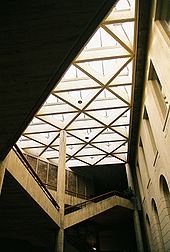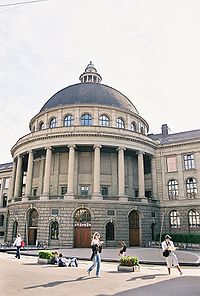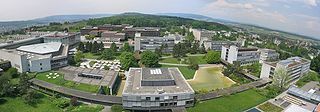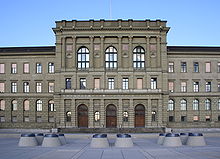历史
ETH was founded in 1854 by the Swiss Confederation and opened its doors in 1855 as a polytechnic institute (Eidgenössische Polytechnische Schule). It comprised in the beginning six departments: architecture, civil engineering, mechanical engineering, chemistry, forestry, and a catch-all department for mathematics, natural sciences, literature, and social and political sciences.
ETH is a federal institute (i.e., under direct administration by the Swiss government), whereas the University of Zurich is a cantonal institution. The decision for a new federal university was heavily disputed at the time, because the liberals pressed for a "federal university", while the conservative forces wanted all universities to remain under cantonal control, with the goal of giving liberal thoughts no refuge. In the beginning, both universities were co–located in the buildings of the University of Zurich.
In 1909, the course program of ETH was restructured to that of a real university, from its early, very schoolish agenda, and ETH was granted the right to award doctorates. In 1911, it was given its current name, Eidgenössische Technische Hochschule. In 1924, another reorganization structured the university in 12 departments. However, it now has 16 departments.

Interior skylights in the main building
Since 1993 ETH Zürich, the EPFL, and four associated research institutes were joined and administered together as the "ETH Bereich".
Reputation
ETH is regularly ranked among the top universities in the world. Typically, popular rankings placed ETH as the best university in Switzerland and on the main European continent, among the top 5 European universities, and among the best 25 of the world (e.g., in 2008, rank 24 in both the Times and Shanghai ranking, see Ranking Overview).
Historically, ETH achieved its reputation particularly in the fields of chemistry, mathematics and physics. There are 21 Nobel Laureates who are associated with ETH, counting only graduates of ETH and Professors who have been honored for their work at ETH. The most recent Nobel Laureate is Kurt Wüthrich who was awarded the Nobel Prize in chemistry in 2002. Albert Einstein is perhaps its most famous alumnus. Other distinguished alumni include Har Gobind Khorana and John Von Neumann.
In a comparison of Swiss universities by swissUP Ranking and a ranking published by CHE comparing the universities of German-speaking countries, ETH traditionally is ranked first in natural sciences, computer science and engineering sciences.
In the survey CHE ExcellenceRanking on the quality of Western European graduate school programmes in the fields biology, chemistry, physics and mathematics, ETH was assessed as one of the three institutions to have excellent graduate programmes in all considered fields, the other two being the Imperial College London and the University of Cambridge. To support its cutting edge research, ETH Zurich saw a budget of 1.3 billion CHF (approx. 1.2 billion USD) in the year 2009.
On the 2009 Times Higher Education-QS World University Rankings list, ETH Zurich was ranked inside the top 50 for the fifth consecutive year. Its currently ranks 10th in the world in field of Engineering & IT and 12th in Natural Sciences. An overview of the last years:
| Year |
Overall Rank (Change) |
| 2005 |
10 |
| 2006 |
24 (▼ 14) |
| 2007 |
42 (▼ 18) |
| 2008 |
24 (▲ 18) |
| 2009 |
20 (▲ 4) |
According to the 2009 Academic Ranking of World University (ARWU) of the Jiao-tong University of Shanghai, the ETH is the 4 best university in Europe, also 6 in chemistry and 9 in mathematics and natural science world-wide .
Admission and education
| Swiss federal institutes of technology and research (ETH domain) |
Budget 2008 (CHF mil.)
|
|
ETH Domain
|
1'939,0
|
Institutes of technology
|
|
|
994,0
488,0
|
Federal Laboratories
|
|
|
238,0
86,3
49,9
49,1
|

Students and locals in ETH front courtyard
ETH is not selective in its undergraduate admission procedures. Like every public university in Switzerland, ETH is obliged to grant admission to every Swiss citizen who took the Matura. It also grants entry to foreign students with certain qualifications, such as A-Levels with GCSE, but only in specific combinations. Most applicants from foreign countries are required to take either the reduced entrance exam or the comprehensive entrance exam; an applicant can be admitted to ETH even without any verifiable educational records by passing the comprehensive entrance exam .
There are no obligatory examinations during the first academic year which is divided into two semesters. However, the actual selection process takes place in the summer shortly after the second semester. Students have to pass the block examinations of courses of the first year, called the Basisprüfung. If the weighted average score is not sufficient, you are required to retake the entire Basisprüfung which usually means that you have to resit through the first year. More than 50% of the students fail the Basisprüfung on first try and many of them choose to drop out after the failure. The structure of examinations in higher academic years is similar to the Basisprüfung (Basis examination), but with a higher success rate. The regular time to reach graduation is six semesters for the Bachelor of Science degree and three further semesters for the Master of Science degree. The last semester is dedicated to writing a thesis.
Education at ETH tends to be theoretically oriented with a high amount of mathematics involved throughout the courses. The main language of teaching in undergraduate studies is German while English is lingua franca in Master's studies and graduate studies.
校园

ETH Hönggerberg with the new HIT building
ETH Zürich has two campuses. The main building was constructed in the 1860s in the heart of the city, and when the university grew, it spread out into the surrounding quarters. Its Zentrum location consists thus of various buildings and institutions throughout Zurich, firmly integrating ETH in the city. The main building is right across the street from the University of Zurich.
Because this geographic situation substantially hindered the expansion of ETH, a new campus was built from 1964 to 1976 on the Hönggerberg in the outskirts of the city. The last major expansion project of this new campus was completed in 2003; since then, the Hönggerberg location houses the departments of materials science, architecture, civil engineering, physics, biology, and chemistry.
Main building

Main building as seen from
Polyterasse
The main building of ETH was built 1861 to 1864 under Gustav Zeuner; the architect, however, was Gottfried Semper, who was a professor of architecture at ETH at the time and one of the most important writers and theorists of the age. Semper worked in a neoclassical style that was unique to him. It emphasized bold and clear massings with a detailing, such as the rusticated ground level and giant order above, that derived in part from the work of Andrea Palladio and Donato Bramante. During the construction of the University of Zurich, the south wing of the building was allocated to the University until its own new main building was constructed (1912 – 1914). At about the same time, Semper's ETH building was enlarged and also got its impressive cupola.
Science City
In the year of ETH's 150th anniversary, an extensive project called "Science City" for the Hönggerberg Campus has begun with the goal to transform the campus into an attractive district based on the principle of sustainability.

ETH Hönggerberg from the south, looking at the five "fingers" of the HCI and behind the high HPP building.
BWI Center for Industrial Management
Formerly known as the Institute of Industrial Engineering and Management of the ETH, The BWI Center for Enterprise Sciences conducts enterprise research as well as education and services for the ETH and commercial enterprises. The private-sector Association for the Promotion of the ETH Institute of Industrial Engineering and Management (BWI) was founded on 26 June 1929. The BWI was inaugurated the same year on 1 October 1929, together with a specialized library. Currently, 650 companies and individual customers draw services of the BWI every year. The subscribers of the journal io new management are not included in that number.
The research of the BWI in the areas logistics, operations and supply chain management, global service management and service innovation addresses enterprises that concentrate on technology and deals with questions and challenges concerning their value added. The goal of the applied science at the BWI is to obtain generalizable recommendations for action for the decision-making of an enterprise on the basis of practice-oriented problems.
BWI Management Further Education “organizes seminars and workshops since 1931. About 150 seminars with 400 seminar days are held every year. The publicly announced seminars cover 45 titles and originate from the four subject areas project management, leadership, supply chain management and management techniques. The company-internal seminars are „in-house“-organized standard seminars for enterprises from the areas engineering industry, information and communication industry, medical engineering, banks and insurance companies, chemical and pharmaceutical industry as well as public administration.
The BWI is editor of the management journal „io new management“. The journal was launched in 1932 as „Industrial Organization“(io). It appears 10 times a year and is now published by Axel Springer Schweiz. The circulation figure in 2008 was, according to WEMF (corp. for advertising media research), 4428.
The know-how group on "Production and Information Management" (Erfa-group PIM) is a working group of participants from industry and the university. It deals with the topics production, logistics and information management. Goal of the Erfa-group PIM is to inform its members about trends and to promote the exchange of experiences.
Student life
ETH students were found to be the busiest students of all institutions of higher education in Switzerland. The undergraduates' tight curriculum consists of as much as twice the number of lectures as comparable courses of other Swiss universities.
ETH has well over 100 student associations. Most notable is the VSETH (Verband der Studierenden an der ETH) which comprises all department associations. The associations regularly organize events with varying size and popularity. Events of the neighboring University of Zurich are well-attended by ETH students and vice versa. The VSETH organizes events of greater public attention, such as the Polyball, the Polyparty and the Erstsemestrigenfest, the first two housed in the main building of ETH. Sometimes, the annual Erstsemestrigenfest takes place at extraordinary locations, for example the Zürich Airport. All freshmen enjoy special treatment at that event.
The Academic Sports Association of Zurich (ASVZ) offers more than 80 sports. The biggest annual sports event is the SOLA-Stafette (SOLA relay race) which consists of 14 sections over a total distance of 120 kilometers. More than 760 teams participated in the 2009 edition.
Traditions
The annual Polyball is the most prestigious public event at ETH, with a long tradition since the 1880s. The end of November, the Polyball welcomes around 10000 dancers, music-lovers and party animals in the extensively decorated main building of ETH. The Polyball is the biggest decorated ball in Europe.
The amicable rivalry between ETH and the neighbouring University of Zurich has been cultivated since 1951 (Uni-Poly). There has been an annual rowing match between teams from the two institutions on the river Limmat.
There are many regular symposia and conferences at ETH, most notably the annual Wolfgang Pauli Lectures, in honor of former ETH Professor Wolfgang Pauli. Distinct lecturers, among them 24 Nobel Laureates, have held lectures of the various fields of natural sciences at this conference since 1962.
Departments
As of 2008, ETH Zurich comprises the following departments:
- Architecture and civil engineering
- Architecture (D-ARCH)
- Civil, Environmental and Geomatic Engineering (D-BAUG)
- Engineering sciences
- Biosystems Science and Engineering (D-BSSE)
- Computer Science (D-INFK)
- Information Technology and Electrical Engineering (D-ITET)
- Mechanical and Process Engineering (D-MAVT)
- Materials Science (D-MATL)
- Natural sciences and mathematics
- Biology (D-BIOL)
- Chemistry and Applied Biosciences (D-CHAB)
- Mathematics (D-MATH)
- Physics (D-PHYS)
- System-oriented natural sciences
- Agriculture and Food Sciences (D-AGRL)
- Earth Sciences (D-ERDW)
- Environmental Sciences (D-UWIS)
- Other sciences
- Humanities, Social and Political Sciences (D-GESS)
- Management, Technology and Economics (D-MTEC)
知名校友与教职
Main article: List of ETH Zurich people
The names listed below are taken from the official record compiled by the ETH. It includes only graduates of the ETH and professors who have been awarded the Nobel Prize for their achievements at ETH. [1]
Nobel Prize in Physics
- 1901 Wilhelm Conrad Röntgen (graduate)
- 1920 Charles-Edouard Guillaume (graduate)
- 1921 Albert Einstein (graduate and professor)
- 1943 Otto Stern (lecturer)
- 1945 Wolfgang Pauli (professor)
- 1952 Felix Bloch (graduate)
- 1986 Heinrich Rohrer (graduate)
- 1987 Georg Bednorz (graduate)
- 1987 Karl Alexander Müller (graduate)
Nobel Prize in Chemistry
- 1913 Alfred Werner (professor)
- 1915 Richard Martin Willstätter (professor)
- 1918 Fritz Haber (graduate)
- 1936 Peter Debye (professor)
- 1938 Richard Kuhn (professor)
- 1939 Leopold Ruzicka (professor)
- 1953 Hermann Staudinger (lecturer)
- 1975 Vladimir Prelog (professor)
- 1991 Richard Ernst (graduate & professor)
- 2002 Kurt Wüthrich (professor)
Nobel Prize in Medicine
- 1978 Werner Arber (graduate)
- 1950 Tadeus Reichstein (graduate)
Other Nobel Laureates directly affiliated with the ETH include
- 1968 Har Gobind Khorana (medicine)
- 1968 Lars Onsager (chemistry)
- 1986 Gerd Binnig (physics)
ETH Zurich has produced and attracted many famous scientists in its short history, including Albert Einstein. More than twenty Nobel laureates have either studied at ETH or were awarded the Nobel Prize for their work achieved at ETH. Other alumni include scientists who were distinguished with the highest honours in their respective fields, amongst them Pritzker Prize and Turing Award winners. Academic achievements aside, ETH has been Alma Mater to many Olympic Medalists and world champions.
[edit] Other affiliates
Architects
- Hendrik Petrus Berlage, architect (student of the ETH)
- Santiago Calatrava, architect (student of the ETH)
- Max Frisch, architect (student of the ETH)
- Jacques Herzog and Pierre de Meuron (Herzog & de Meuron), architects (students of the ETH, professor at the ETH since 1999, received the Pritzker Prize in 2001)
- Aldo Rossi, architect (Professor at the ETH, received the Pritzker Prize in 1990)
- Gottfried Semper, architect (Professor at the ETH)
- Bernard Tschumi, architect (student of the ETH)
Engineers
- Othmar Ammann, civil engineer (student of the ETH)
- Hans Albert Einstein, civil engineer (student of the ETH)
- Karl Culmann, structural engineer (Professor at the ETH)
- Maurice Koechlin, structural engineer (student of the ETH)
- Christian Menn, structural engineer (student of the ETH, Professor at the ETH)
- Jan A. Rajchman, electrical engineer (student of the ETH)
- Rudolf Kalman, electrical engineer, mathematician (Professor at the ETH)
- Jakob Ackeret, aeronautical engineer (student of the ETH, Professor at the ETH)
- Wernher von Braun, aerospace engineer (student of the ETH)
- Herbert Einstein, civil engineer (student of the ETH, Professor at MIT)
Mathematicians
- Lars Ahlfors, mathematician (Professor at the ETH)
- Armand Borel, mathematician, (student of ETH, Professor at the ETH)
- Georg Cantor, mathematician (student of the ETH) Known for: Cantor's Theorem (pure mathematics, set theory)
- Richard Dedekind, mathematician (Professor at the ETH)
- Beno Eckmann, mathematician (student of ETH, Professor at the ETH)
- Ferdinand Georg Frobenius, mathematician (Professor at the ETH) Known for: Frobenius method (Differential equations), Frobenius Group (Group theory, Differential Geometry)
- Heinrich Guggenheimer, mathematician, (student of the ETH)
- Heinz Hopf, mathematician (Professor at the ETH)
- Adolf Hurwitz, mathematician (Professor at the ETH)
- Marcel Grossmann, mathematician (student of the ETH, Professor at the ETH) Known for teaching Einstein Differential geometry and tensors
- Philippe Kahn, mathematician, entrepreneur, inventor (student of the ETH)
- Mileva Marić, mathematician, (student of the ETH)
- Hermann Minkowski, mathematician (Professor at the ETH) Known for: Minkowski Space (Relativity)
- Jürgen Moser, mathematician (Professor at the ETH)
- John von Neumann, mathematician, computer scientist (student of the ETH)
- Hermann Amandus Schwarz, mathematician (Professor at the ETH)
- Eduard Imhof, cartographer (Student of the ETH, Professor at the ETH)
- George Pólya, mathematician (Professor at the ETH)
- Eduard Stiefel, mathematician (student of ETH, Professor at the ETH)
- Hermann Weyl, mathematician (Professor at the ETH) Known for: Einstein-Weyl group (Quantum Field Theory)
| Individual |
Profession |
Affiliation with ETH |
| Konrad Osterwalder |
mathematician, physicist |
Student, Professor |
| Robert Schrader |
mathematician, physicist |
Student |
| Jürg Fröhlich |
mathematician, physicist |
Student, Professor |
| Demetrios Christodoulou |
mathematician, physicist |
Professor |
Other fields
- Kenneth Hsu, geologist (Professor at the ETH)
- François Diederich, chemist (Professor at the ETH)
- Carl Gustav Jung, psychologist, (Professor at the ETH)
- Rudolf Clausius, physicist (student of the ETH)
- Valentine Telegdi, physicist (student of the ETH, Professor at the ETH, received the Wolf Prize in 1991)
- Fritz Zwicky, astronomer, (student of ETH, received the Gold Medal of the Royal Astronomical Society in 1972)
- Jacob Burckhardt, historian (Professor at the ETH)
- Paul Feyerabend, philosopher (Professor at the ETH)
- Auguste Piccard, physicist, inventor, explorer (student of the ETH, Professor at the ETH)
- Niklaus Wirth, computer scientist (Professor at the ETH since 1968, received the Turing Award in 1984)
- Kārlis Ulmanis, politician (student of the ETH)
- Robert Oppenheimer, physicist (worked with Wolfgang Pauli)
- Carlos Kleiber, (orchestral conductor), (studied chemistry at the ETH)
Master programs
ETH runs two series of masters degrees, both lasting for four semesters. Around 40 full-time programmes lead to Master of Science or Master of Arts degrees.[2] They are open to applicants with bachelors degrees. A further 14 programmes lead to Master of Advanced Studies or the MBA.[3] These continuing education courses are open only to applicants who already hold a masters degree. The better-known international programmes include:
- Master of Advanced Studies in Management, Technology, and Economics
- Master of Arts in Comparative and International Studies (MACIS)
- Master of Science in Computer Science
- Master of Science in Quantitative Finance
- Master of Science in Micro and NanoSystems
- Master of Science in Statistics
Gallery
ETH HIT building from inside
|
|
ETH HIT F 21 Seminar room
|
ETH HIL, HIP, and HIT buildings
|
|
|
更多
- Science and technology in Switzerland
- École Polytechnique Fédérale de Lausanne (Swiss Federal Institute of Technology in Lausanne- EPFL).
- Category:ETH Zurich alumni
- Category:ETH Zurich faculty
- Walt Disney Research
- University of Zurich
- List of universities in Switzerland
- List of forestry universities and colleges
- 2000-watt society
- serec (Swiss Electromagnetics Research & Engineering Centre)
- myScience.ch - The Swiss Portal for Research and Innovation
参考文献
- ^ "Times Higher Education" (English)
- ^ "ETH moves up a rank" (English)
- ^ "Entry for international students" (German)
- ^ "Willkommen auf Students.ch" (German)
- ^ SOLA-Stafette 2009
- Annual Report 2009 BWI Center for Industrial Management. Logistics, Operations, and Supply Chain Management
External links
 |
Wikimedia Commons has media related to: ETH Zurich |
- Official website
- BWI Center for Industrial Management
- Information's about ETH Zurich
- Webcams at the ETH



